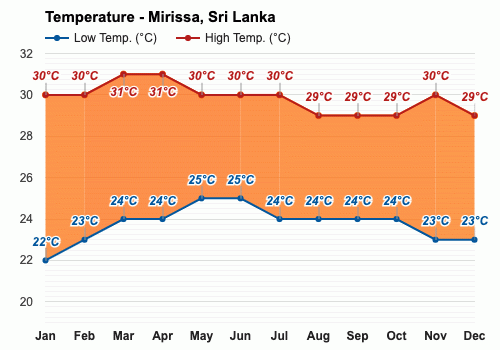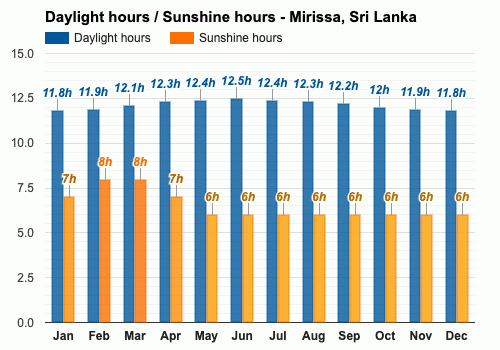Contents
- The climate of Mirissa
- The best time to visit Mirissa
- The worst time to visit Mirissa
- Spring weather in Mirissa
- Summer weather in Mirissa
- Autumn weather in Mirissa
- Winter weather in Mirissa
- Weather in January
- Weather in February
- Weather in March
- Weather in April
- Weather in May
- Weather in June
- Weather in July
- Weather in August
- Weather in September
- Weather in October
- Weather in November
- Weather in December
- Frequently asked questions
- Average temperature
- Average rainfall
- Average rainfall days
- Average sea temperature
- Average daylight
- Average sunshine
- Average UV index

The climate of Mirissa
Throughout the 12 months, daytime temperatures fluctuate moderately, ranging from a high of 30°C (86°F) to 31°C (87.8°F). Meanwhile, nighttime temperatures see a similar consistency, varying from 22°C (71.6°F) to 25°C (77°F). Hence, no significant temperature extremes exist, rendering the yearly weather typically warm to hot.
Rainfall levels show some variations throughout the year. The amounts even out between 89mm (3.5") and 305mm (12.01") per month. The number of rainfall days similarly varies, tallying between 5 and 14 days monthly. Thus, months might harbor, on one extreme, heavy rains, and on the other, less sizable amounts.
UV Index remains consistently high throughout the year with values of 11 to 12. Lastly, sunshine hours and daylight hours proffer a consistent experience of ample light, with their values fluctuating between 6 to 8 hours and 11.8 to 12.5 hours, respectively.
The best time to visit Mirissa
The worst time to visit Mirissa
Spring weather in Mirissa
Summer weather in Mirissa
Autumn weather in Mirissa
Winter weather in Mirissa
Weather in January
Weather in February
Weather in March
Weather in April
Weather in May
Weather in June
Weather in July
Weather in August
Weather in September
Weather in October
Weather in November
Weather in December
Frequently asked questions
What is the driest month in Mirissa?
How much does it rain in Mirissa?
What months are the sea coldest in Mirissa?
When is the highest UV index in Mirissa?
What are the months with the most sunshine in Mirissa?
What part of the year is the hottest in Mirissa?
What month is the sea warmest in Mirissa?
What is the month with the least sunshine in Mirissa?
When are the longest days in Mirissa?
What is the coldest time of year in Mirissa?
What is the rainiest month in Mirissa?
When is the lowest UV index in Mirissa?
What is the month with the shortest days in Mirissa?
Is there Daylight Saving Time (DST) in Mirissa?
Average temperature
Mirissa, Sri Lanka

The warmest months (with the highest average high temperature) are March and April (31°C).
The months with the lowest average high temperature are August, September, October and December (29°C).
The months with the highest average low temperature are May and June (25°C).
The coldest month (with the lowest average low temperature) is January (22°C).
Average rainfall
Mirissa, Sri Lanka

- Average rainfall in January:
89mm - Average rainfall in February:
91mm - Average rainfall in March:
109mm - Average rainfall in April:
207mm - Average rainfall in May:
258mm - Average rainfall in June:
173mm
- Average rainfall in July:
173mm - Average rainfall in August:
149mm - Average rainfall in September:
215mm - Average rainfall in October:
305mm - Average rainfall in November:
276mm - Average rainfall in December:
171mm
The wettest month (with the highest rainfall) is October (305mm).
The driest month (with the least rainfall) is January (89mm).
Average rainfall days
Mirissa, Sri Lanka

- Average rainfall days in January:
5 days - Average rainfall days in February:
5 days - Average rainfall days in March:
7 days - Average rainfall days in April:
11 days - Average rainfall days in May:
11 days - Average rainfall days in June:
11 days
- Average rainfall days in July:
9 days - Average rainfall days in August:
9 days - Average rainfall days in September:
11 days - Average rainfall days in October:
13 days - Average rainfall days in November:
14 days - Average rainfall days in December:
10 days
The month with the highest number of rainy days is November (14 days).
The months with the least rainy days are January and February (5 days).
Average sea temperature
Mirissa, Sri Lanka

The best month for swimming (with the highest average sea temperature) is April (30°C).
The coldest months (with the lowest average sea temperature) are January, February, June, July, August, September, October and December (28°C).
Average daylight / Average sunshine
Mirissa, Sri Lanka

- Average daylight in January:
11h and 5min - Average daylight in February:
11h and 5min - Average daylight in March:
12h and 1min - Average daylight in April:
12h and 2min - Average daylight in May:
12h and 2min - Average daylight in June:
12h and 3min
- Average daylight in July:
12h and 2min - Average daylight in August:
12h and 2min - Average daylight in September:
12h and 1min - Average daylight in October:
12h and 0min - Average daylight in November:
11h and 5min - Average daylight in December:
11h and 5min
The month with the longest days is June (Average daylight: 12h and 30min).
The month with the shortest days is December (Average daylight: 11h and 48min).
The months with the most sunshine are February and March (Average sunshine: 8h).
The months with the least sunshine are May, June, July, August, September, October, November and December (Average sunshine: 6h).
Average UV index
Mirissa, Sri Lanka

The months with the highest UV index are January, February, March, April, May, June, July, August, September and October (UV index 12).
The months with the lowest UV index are November and December (UV index 11).
Mirissa, Sri Lanka
Weather forecast for your location
2. Allow the app to use your location


